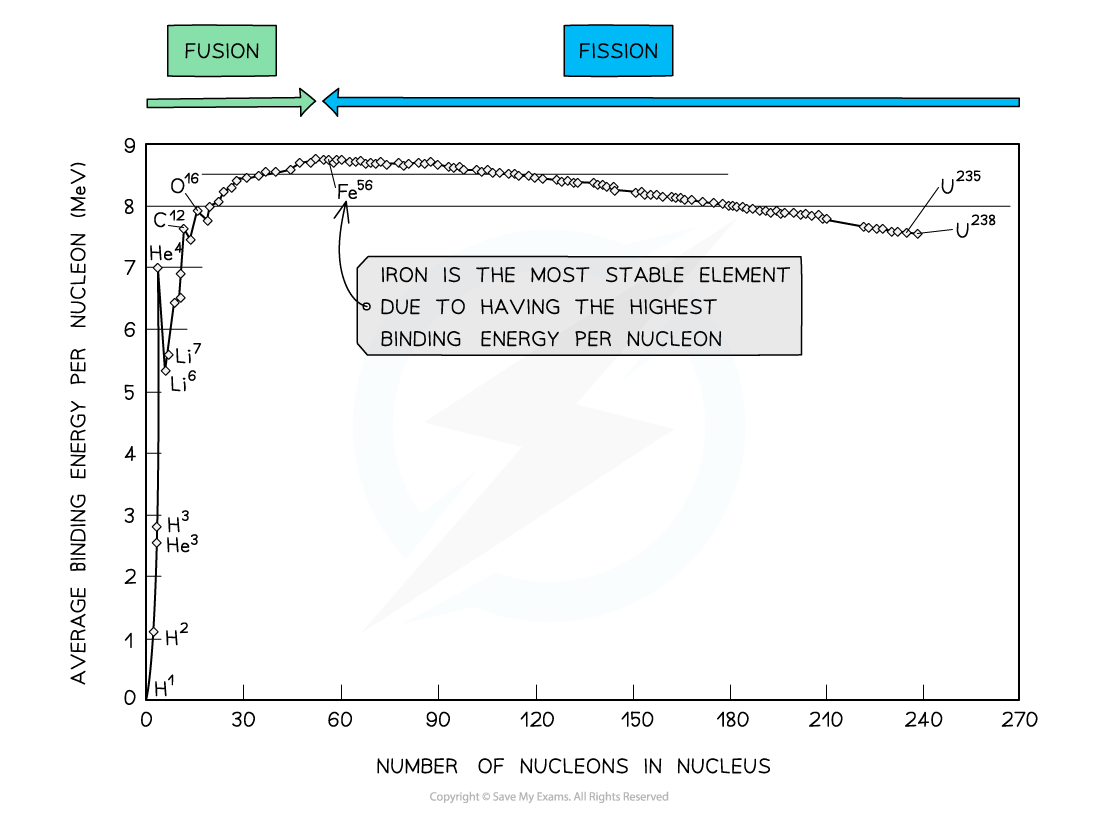Binding Energy per Nucleon Graph (Edexcel International A Level (IAL) Physics): Revision Note
Exam code: YPH11
Binding Energy per Nucleon Graph
When comparing the stability of different nuclei, it is useful to look at the binding energy per nucleon
The binding energy per nucleon is defined as:
The binding energy of a nucleus divided by the number of nucleons in the nucleus
A higher binding energy per nucleon indicates a higher stability since it requires more energy to pull the nucleus apart
Iron (A = 56) has the highest binding energy per nucleon, which makes it the most stable of all the elements

By plotting a graph of binding energy per nucleon against nucleon number, the stability of elements can be inferred
Key Features of the Graph
At low values of A:
Nuclei tend to have a lower binding energy per nucleon, hence, they are generally less stable
This means the lightest elements have weaker electrostatic forces and are the most likely to undergo fusion
Helium (4He), carbon (12C) and oxygen (16O) do not fit the trend
Helium-4 is a particularly stable nucleus hence it has a high binding energy per nucleon
Carbon-12 and oxygen-16 can be considered to be three and four helium nuclei, respectively, bound together
At high values of A:
The general binding energy per nucleon is high and gradually decreases with A
This means the heaviest elements are the most unstable and likely to undergo fission
Worked Example
Determine the binding energy per nucleon of Iron-56 () in MeV
Mass of a neutron = 1.675 × 10−27 kg
Mass of a proton = 1.673 × 10−27 kg
Mass of a nucleus = 9.288 × 10−26 kg
Answer:
Step 1: Calculate the mass defect
Number of protons, Z = 26
Number of neutrons, A – Z = 56 – 26 = 30
Mass defect, Δm = Zmp + (A – Z)mn – mtotal
Δm = (26 × 1.673 × 10-27) + (30 × 1.675 × 10-27) – (9.288 × 10-26)
Δm = 8.680 × 10-28 kg
Step 2: Calculate the binding energy of the nucleus
Binding energy, ΔE = Δmc2
E = (8.680 × 10-28) × (3.00 × 108)2 = 7.812 × 10-11 J
Step 3: Calculate the binding energy per nucleon
Binding energy per nucleon =
Step 4: Convert to MeV
J → eV: divide by 1.6 × 10-19
eV → MeV: divide by 106
binding energy per nucleon =
Examiner Tips and Tricks
Checklist on what to include (and what not to include) in an exam question asking you to draw a graph of binding energy per nucleon against nucleon number:
You will be expected to draw the best fit curve AND a cross to show the anomaly that is Helium
Do not begin your curve at A = 0, this is not a nucleus!
Make sure to correctly label both axes AND units for binding energy per nucleon
You will be expected to include numbers on the axes, mainly at the peak to show the position of iron (56Fe)

Unlock more, it's free!
Did this page help you?